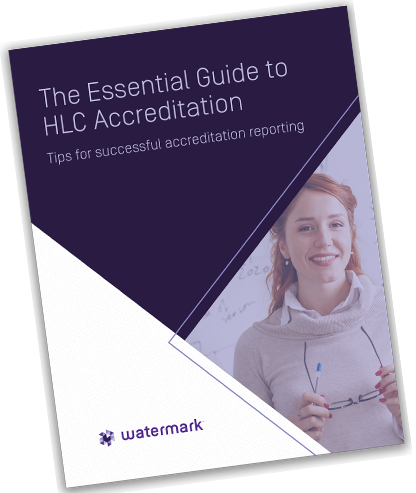The Higher Learning Commission (HLC) is an independent accrediting agency founded in 1895. It accredits higher education institutions across the United States and works proactively to support students, their institutions, and communities. The HLC accredits institutions holistically. It fosters a culture of continuous improvement in academic quality, ethics, and institutional effectiveness.
Higher education institutions that meet HLC standards have the distinction of offering more than a high-quality education. They also provide effective student support services, develop their faculty, and act responsibly in all processes from admission to degree completion. To achieve successful HLC accreditation, it’s essential to understand the detailed processes involved. While the process can be challenging, you can use the right tools to access, simplify, and enhance the value of your institution’s data.
In this ebook, we’ll look closely at HLC accreditation criteria and outline how you can use technology to support you on your road to accreditation.


The HLC constructs its policies to promote quality higher education. To be eligible for HLC accreditation, you must meet their financial, operational, and legal requirements. You must be legally authorized to award degrees and have a governing board free from external influence. Your institution must demonstrate operational stability, possess an approved mission statement, and offer quality educational programs.
Accredited institutions meet the HLC’s eligibility requirements, criteria for accreditation, assumed practices, membership obligations, and any other federal compliance requirements. The first step to HLC accreditation is understanding these elements in detail.
In June 2024, the HLC revised the accreditation criteria, assumed practices, and evaluative framework for accreditation. These revisions come into effect on Sept. 1, 2025. The revised criteria for HLC accreditation include:
If your institution has received HLC accreditation in the past, you can retain it through a comprehensive reaffirmation process. Reaffirmation will occur within four years of initial accreditation.
Everything in your organization should flow from and support your institution’s mission statement. Review your mission statement to ensure it reflects the current purpose of the institution. The mission statement should make a promise to students, faculty, and the community at large, and it should also state what your institution intends to achieve in the next three, five, or ten years.
A good mission statement is specific enough to guide an institution’s colleges, schools, and departments. Mission statements evolve over time, and sometimes, when the mission statement changes, not everyone is aware of the change. Watermark Planning & Self-Study eliminates this challenge by providing a single location where everyone can find the latest version of the mission statement. Planning & Self-Study also keeps an archive of all iterations of the statement for reference.
Academic and operational units can create and revise their insights about how their outcomes assessments relate to the mission statement. The tool creates an archive of these inputs, documenting how the institution has aligned its goals with changing institutional missions over time.
The accreditation process brings your institution’s overall quality and effectiveness to light. In the process of gathering the necessary evidence, you learn in no uncertain terms whether your institution has the qualities of an HLC-accredited college or university. In simple terms, a successful accreditation demonstrates that:
The presence of these elements indicates that your institution aligns with the criteria set by the HLC. Some other tips for successful HLC accreditation include:
Your institution’s mission statement is at the center of your operations. Every decision you make should align with your overarching mission and goals, as your mission statement acts as a promise to all stakeholders to provide a quality education. Assess your current mission statement to ensure it reflects your institution’s current purpose and that it states what you intend to achieve in the long term.
An effective mission statement is detailed enough to guide each department. As goals and student needs evolve, so does your mission statement. When you update your mission statement, ensure everyone has access to the latest version from a centralized location. Keep the previous versions of your mission statement in the same place for reference.
Each academic and operational department at your institution can create and revise insights based on how outcomes assessments relate to your mission statement. As your mission statement evolves, you can use technology tools to create an archive of new inputs, which showcases how your institution has aligned its goals with your mission over time.
Many faculty members have defined career goals, including receiving tenure. They must meet the stringent requirements of your institution, collecting and documenting their credentials as they work toward your goals. Every time they achieve a goal, they create high-quality data you can leverage to meet accreditation requirements.
When faculty document their achievements, they must focus on showing how they help your institution achieve its mission. They can start by demonstrating that their course content impacts student outcomes and attendance. Consider faculty data outside of their current roles, including any work they have completed in roles that relate to the subjects they teach.
It’s essential to identify and correct any gaps in faculty credentials that could be an issue during HLC accreditation. With a consistent dataset, you can quickly fill in the gaps and demonstrate faculty impact with ease. Use purpose-built higher education software to capture faculty activity in a format that streamlines meeting accreditation requirements.
Your institution’s Office of Institutional Planning and Effectiveness can use its focus on continuous improvement to guide your institution as it works to fulfill its mission. Higher education is a rapidly changing landscape, and your ability to define and measure student learning and operational effectiveness outcomes is increasingly crucial. This office will keep an eye on new trends and implement solutions based on the evolving environment. In doing so, your Office of Institutional Planning and Effectiveness will:
With the right technology at your disposal, your Office of Institutional Planning and Effectiveness can measure holistic results and identify the best adjustments to make to improve every accreditation cycle.
When you can document student achievement and outcomes efficiently, the results extend beyond accreditation reporting. Prospective students consider various factors when they decide which institution to attend, and academic quality is among their top priorities. A comprehensive reporting system is essential for standing out from other institutions. Measuring student achievement also gives you actionable insights on where to invest your resources, making it vital for your bottom line.
Meaningful technology offers many methods to manage assessment in a way that complements your institution. Give students actionable feedback that supports their progress while obtaining the data they need to drive improvement and demonstrate compliance. Measuring student outcomes means you can report the results to stakeholders. You must analyze the results to assess whether you’re meeting your outcomes objectives and plan continuous improvement for any areas where you fall short.
The HLC requires institutions to participate in a self-study, the details of which culminate in an extensive written report. Your report should create a narrative of your journey through continuous improvement, educational quality, and meeting HLC accreditation criteria. Base the report on the findings of your self-study and organize the sections to incorporate data and extensive evidence. Structure your report to include:
Your self-study report relies on accurate, high-quality data to prove compliance with HLC criteria. Instead of scrambling at the last minute, use specialized templates and delegate responsibilities across teams. Your leadership team can access ongoing comments and documentation added across all collaborators. Innovative technology means you can track your progress holistically and embed documentation effortlessly throughout the reports.
HLC accreditation is about using data to showcase your institution’s impact on students, faculty, and the entire community. If you only think about accreditation processes when it’s time to prepare, you lose masses of data that could transform your institution. Leverage technology to keep data at your fingertips, and you’ll always have access to actionable insights that define your narrative and drive continuous improvement.
Focus on technology providers that partner with you throughout the accreditation process, providing consistent access to your data so you can make improvements in real time. With Watermark, you can connect the dots between the core components of HLC standards.
The complete Watermark Educational Impact Suite (EIS) is a centralized hub of solutions designed for higher education, simplifying data collection and making the assessment process more manageable. Request a demo today to take a deep dive into your data and gather the insights you need to drive improvement at your institution.

See how our tools are helping clients right now, get in-depth information on topics that matter, and stay up-to-date on trends in higher ed.